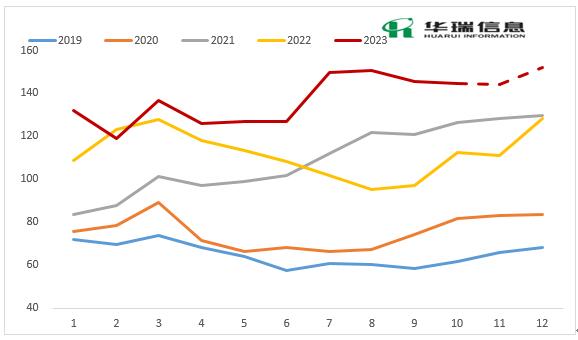MEG supply/demand structure to weaken in Dec-Jan
In last week's article, we mentioned that due to an increase in annual capacity and a slowdown in production growth, the supply and demand structure of MEG in China is expected to improve in 2024 compared to the past two years. However, with the recent successful trial runs of Yuneng's 400kt/year and Xinjiang Zhongkun's 600kt/year new units, along with the delay of Yulin Chemical's 1.8 million mt/year maintenance to the end of December, the supply pressure for the EG2401 contract is slightly higher, indicating a relative weakening in the market fundamentals.
Regarding new units, Yuneng's 400kt/year unit began trial runs at the end of October and is progressing well, expected to get products by mid-November. Xinjiang Zhongkun's 600kt/year unit started trials in early November, aiming to produce polyester-grade MEG by around November 27. Based on this timeline, both units will contribute to actual production in December, likely leading to a record high in domestic production of MEG.
China domestic MEG production
Unit: 10,000 tons
In terms of imports, negotiations for 2024 term contracts have been ongoing since the end of last month. Currently, the mainstream suppliers have slightly reduced their discount offers. Despite the rise in domestic production and consideration of the import/domestic price spread, negotiations remain stagnated. Contrary to the strategy of reduced production and increased efficiency, North American MEG inventory pressure has been high. With current high operation rates, the pressure on shore tanks will become more evident, and these inventories will still need to find sales destinations, as heard this week with 20-30-kt offers from Nan Ya. However, congestion in the Panama Canal could affect shipping efficiency and is worth monitoring.
Additionally, the Indian Reliance unit is operating at a high rate, and PRefChem plans to start supplying in late November, indicating a weakening supply-demand structure in the Asian market.
On the demand side, the textile weaving sector is showing signs of sluggishness. Seasonal demand is declining, and weaving factories in various regions report weaker new orders and rising inventory pressures, most directly reflected in the declining operating rates of printing and dyeing. Polyester filament is accumulating seasonal negative feedback.
Assessing the EG2401 contract supply-demand structure, November appears to be in a loose balance, while December and January may enter a phase of inventory accumulation. Therefore, in the short to medium term, the inventory pressure of MEG remains difficult to alleviate, with weak fundamental drivers around the Chinese New Year contract period.
- Top keywords
- Cotton Price
- Cotton Futures Price
- Cotton Futures
- CZCE
- PTA Futures Price
- Chemical Fiber
- Polyester Prices
- Wool price
- PTA Futures
- Shengze Silk
- China
- Yarn Price
- price
- China Textile City
- Fibre Price
- Benzene Price
- Cotton
- Index
- Cotton Index
- PTA
- fabric price
- NYMEX
- Top 10
- textile industry
- Spot Cotton
- Cotton Yarn
- Polyester Price
- Futures
- PTA Price
- cotton yarn price

